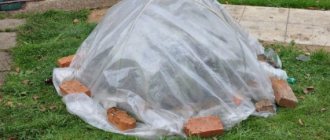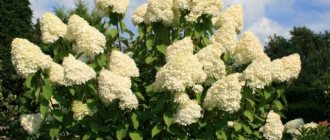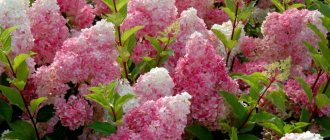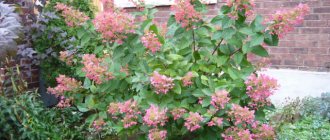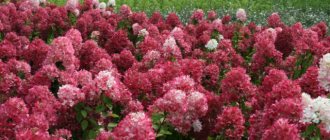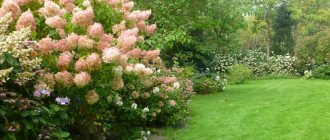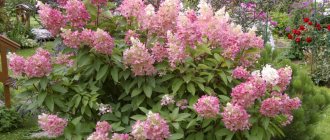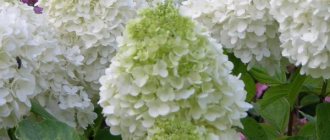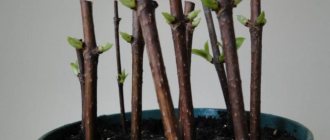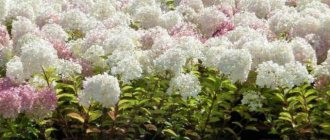Description of hydrangea Sunday Fries
If you compare the botanical description of the perennial flowering hybrid with the parent Vanilla Fraze, you can see some differences.
Thus, Sundae Fraise has a more symmetrical appearance, as well as a compact, even crown. Erect shoots form a dense dense bush measuring 1x1 m. The branches are densely leafy, covered with burgundy-brown bark. The leaf blades are dark emerald green, 10-12 cm long, ovoid in shape, with pointed tips and slightly jagged edges. The surface has a velvety texture, covered with fine pile, and has clearly defined veins. Hydrangea blooms abundantly and for a long time - from the beginning of summer until the first frost. The panicle inflorescences are cone-shaped, about 30 cm in size, and consist of many small flowers with a diameter of 20-25 mm. Over the entire season, the color of Sunday Fries changes from creamy white to pink and bright crimson. At the same time, the intensity of the color depends on the pH level of the soil - in acidic soil the shade becomes more saturated.
The color of the flowers varies from creamy white to pink and bright crimson.
Pros and cons of the variety
Like most hybrids, Sundae Fraise has its strengths and weaknesses.
Advantages of the cultivar:
- high decorative qualities;
- continuous flowering for 4-5 months;
- good tolerance to increased gas pollution;
- ability to grow in shaded areas.
Disadvantages of the variety:
- low winter hardiness threshold;
- poor tolerance to dry periods;
- the need to control soil acidity levels.
Video “Description of the hydrangea variety Sunday Fries”
In this video, experts talk about the advantages of garden culture.
Top dressing
Caring for paniculata Sunday Frize hydrangea also includes fertilizing the bush. It is important to fertilize at least once a year, especially at the beginning of summer.
Also important:
- Feed the plant with a mixture of fertilizers containing microelements.
- Repeat feeding during bud formation.
- Additionally, fertilize with a solution of manganese-acid potassium, which will help increase the strength of the shoots.
- Mulch the plant with peat or sawdust, a layer approximately 6 cm thick. You need to do the procedure in the summer and do not forget to leave a free area near the trunks.
- Loosen together with weeding no deeper than 6 cm, and at the same time you need to water 2-3 times a season.
Agrotechnical features
Sundae fraise does not have high requirements for cultivation and care. Hydrangea should be placed in a bright area if you live in central Russia or in the northern region of the country, and in partial shade if you are in an area with a southern climate. Make sure that the summer midday sun does not harm your beauty. Protect the flower from cold drafts.
The French diva prefers moist, highly fertile soils with an acidic reaction (optimal substrate pH 4-6.5). By the way, the more acidic the soil in which you plant Sunday Frize is, the more intense the shade of the inflorescences on the plant will be. Stick to the following composition of the soil mixture: 2 parts leaf soil, 2 parts humus, 1 part sand and the same amount of peat.
Dig a planting hole 30 cm deep and wide. Place a good drainage layer on the bottom, then fill it with soil. When planting, let the root collar of the plant remain above the soil surface. At the end of this procedure, water the seedling thoroughly. Avoid the presence of ash and lime in the soil under the flower. Do not add dolomite flour and chalk to the soil under hydrangea.
The acidity level of the substrate can be increased by enriching the soil with ammonium sulfate, ferrous sulfate or potassium sulfate. An alternative to this method is to add organic acids to the water for watering the flower - for example, acetic or citric - in a proportion of 10 grams of substance per 1 liter of liquid.
For irrigation, use settled water slightly warmed in the sun. About 10 liters of water are poured under the Sunday Frize bush. Periodically loosen the soil and mulch it with pine needles, peat or sawdust so that moisture is retained in the ground longer. A good way to reduce plant water loss is regular weeding. Also, do not plant hydrangea near other shrubs and tall moisture-loving trees.
The plant requires feeding. They should be carried out no more than once every 2 weeks. The shrub is susceptible to alternating organic matter and mineral complexes. The first is slurry and water infusion of bird droppings. The best mineral concentrates for culture are potassium nitrate and superphosphate.
Sunday Frize shows spring and autumn patterns. In April, the crop is removed from diseased, dry and damaged shoots, and stems that are too long are shortened in order to form a bush. In autumn, sanitary pruning is carried out and dried inflorescences are removed.
Despite its winter hardiness, the shrub is earthed up with the onset of cold weather. The height of the earthen mound you create should be in the range from 20 to 30 cm. When growing a crop in harsh climatic conditions, a frame covered with film is created above it. To preserve last year's hydrangea shoots, which will produce lush inflorescences in the spring, you should bend them to the ground, cover the Sunday Fries bush with fallen leaves on top and cover it with a wooden box.
The plant is threatened by several diseases. We are talking about chlorosis, gray rot, downy mildew. Sundae fraise is also capable of attacking insect pests: aphids, spider mites, golden bronze beetles, leaf roller caterpillars, hairy deer and others. Preventive treatment of the bush will help to avoid these troubles: in the first case - with a fungicide solution, in the second - with an insecticidal preparation. Your plant will be reliably protected from the development of chlorosis if you take care that there is no excess lime in the soil underneath it.
Planting: how to plant a plant
Hydrangea Dolly - description, planting and care
The shrub is rarely propagated by seeds. The seeds germinate poorly and it takes a long time to get a full-fledged bush. It is for this reason that hydrangea is bred by cuttings, layering or dividing the bush.
Planting is best done in spring. Over the summer, the seedling will take root and gain strength for the coming winter. According to the description, Sundae Fraise hydrangea prefers to grow in partial shade. For planting in open ground, it is better to choose four-year-old seedlings.
The first step is to prepare the soil. Prepare a hole up to half a meter deep and 50-70 cm wide. One third of it is filled with a mixture of garden soil, peat, humus and sand. All components are taken in equal proportions. Water the hole well with water.
Planting hole needs watering
Before planting, the seedling can be soaked in a solution of a root-forming agent (Zircon or Kornerost). During planting, the roots are straightened. The root collar should be above the ground. If the neck is deepened, the plant will develop poorly. After spreading the roots over the surface of the soil in the hole, they are carefully sprinkled with earth and watered abundantly. After this, the ground around the seedling is mulched with straw, peat or sawdust.
Selection of location and soil
Despite the ability to grow on any type of soil, the plant will show maximum decorativeness on light, loose soil with a high content of mineral and organic fertilizers.
It grows well in a shaded area; in the sun, the foliage and inflorescences quickly fade. You should not plant shrubs in a garden bed where there is constant shade - the stems will begin to stretch, the leaves will turn pale, and the flowering will not be as bright and long-lasting.
Choose a place protected from the winds - this way you will eliminate the risk of the soil and roots drying out. The optimal depth of groundwater is 2-2.5 m.
This plant prefers to grow in acidic soil, which promotes brighter and more luxuriant flowering. To maintain this indicator at the required level, potassium sulfate, ammonium sulfate or ferrous sulfate is added to the site before planting. The dosage is indicated on the packaging.
Preparation of planting material
For planting, you can use purchased seedlings from a gardening nursery. When purchasing, carefully inspect the crown - there should be no signs of diseases or pests.
Choose plants that are 4-5 years old. These flowers have a well-developed root system, and the crown consists of several shoots. The underground part should be with a lump of earth or planted in a container. Bushes with bare roots dry out quickly, and after planting on the site they may not take root.
Before planting, the plant is watered abundantly, after an hour it is removed from the container and the roots are inspected. All questionable parts are trimmed with sterile pruning shears, then irrigated with a solution of copper sulfate.
If you have acquired seedlings with bare roots, then before planting the root system is soaked in Kornevin or Zircon for 60 minutes. This treatment stimulates rapid and successful rooting.
Planting a plant
Planting a flower and caring for it is simple. It is worth noting that this species is shade-tolerant and can be planted in dark places. The shrub can also be grown in open, sunny areas, but then the flowers will fade and be too pale.
Another important factor is that the bushes do not tolerate strong winds. Gusts of wind have a negative impact on both the entire bush as a whole and its individual parts, especially the inflorescences.
For planting, it is advisable to choose fertile and loamy soils. It is undesirable to plant shrubs on sandy and calcareous soil, as well as soils with neutral or low acidity; the inflorescences become less saturated in color. In order to make the soil for shrubs acidic, you can add brown peat, sawdust or spruce or pine compost.
The shrub loves moist soil; it can even grow in marshy soils, so you can choose places where water accumulates in the spring.
Another important question is when to plant shrubs? In spring or autumn? The most favorable time is the beginning of May or September. The choice of planting time also depends on climatic conditions. In more northern regions it is better to plant in spring. In the southern zone both in spring and autumn.
Soil mixture for growing:
- Humus (one part);
- Turf land (one part);
- Chernozem (one part);
- Peat (one part);
- Urea (20-25 g);
- Potassium sulfate (30 g)
- Superphosphate or bone meal (160-250 g).
Paniculate varieties are recommended to be planted at a distance of 150-250 cm from each other. When planting shrubs in one row, it is recommended to choose a distance of 100-150 cm from each other.
The hole for planting must be dug to a depth of 40-55 cm and a width of 55-60 cm. The width of the hole should be greater than the depth, since the root system grows primarily in breadth. The root collar should be located at ground level, otherwise the bush will not grow well. It is recommended to plant seedlings in a permanent location at 4-5 years of age.
Description of landing:
- 20-30 days before planting it is necessary to dig a hole;
- The day before planting, you need to pour 2 buckets of water into the hole and leave overnight so that the moisture is absorbed;
- Then you need to prepare the soil mixture for planting material;
- Then you should place the seedling on a cone of soil mixture, then carefully straighten the roots;
- Then you need to dig a hole and lightly compact the soil;
- Water the bush with water (9-15 liters);
- Then sprinkle with sawdust or peat (8-10 cm thick);
- At the end of planting, you need to cover the plant from sunlight and winds.
Characteristics
The best way to demonstrate how Hydrangea paniculata Sundae Fraise differs from others is in a photo where it contrasts with any of the taller varieties. The charming bush does not exceed a meter in height.
Multi-stemmed, fast-growing, disease- and pest-resistant highly ornamental shrub. Hydrangea paniculata Sunday Fries ('Rensun' and 'Strawberry Sundae' - this is also planted in Moscow) is thriving, despite dust, soot and exceeding the maximum permissible concentration for ... (something there). Does not tolerate soil drying out. Long before the “critical point,” it hangs its leaves reproachfully, calling on its owners to take up the watering can.
Indifferent to how low the thermometer drops in winter. After all, flowers form on the branches of the current year. Only very young seedlings are covered, and then to protect not the branches, but the roots.
The crown is dense, evenly developed. The branches are red-brown, crowned with wide-conical panicles 25 cm or more in length. Under the weight of many inflorescences they droop picturesquely, but do not lie on the ground.
The foliage is dense. The leaves are bright green, oval, arranged oppositely, covered with thin, short, soft hair. On the underside of the leaf, especially along the veins, the pubescence is more noticeable.
In terms of flowering time, the dwarf hydrangea Sundae Fraise is a real giant: from June to the end of September. In the city limits, where it is noticeably warmer, and even longer - until October.
Hydrangea care
Caring for hydrangea is quite simple. However, in order for hydrangea to produce lush blooms, it is necessary to follow certain care rules.
Basic care includes:
- Watering;
- Loosening the soil and removing weeds;
- Prevention of pests and diseases;
- Application of mineral and organic fertilizers;
- Trimming.
It is worth telling in more detail about each point.
Watering.
Hydrangea loves abundant watering. Every day the bushes need to be watered with 4-5 liters of water. In hot weather, the amount of watering should be increased.
If the soil is mulched with peat, you can water it less often, since peat absorbs moisture very well and can remain wet for a long time.
Loosening and removing weeds.
Several times during the spring and summer season it is necessary to loosen the soil to a depth of 5-7 cm so that the soil is saturated with oxygen. Weeds must be removed as they appear.
Pest and disease control.
Shrub diseases are divided into two types: viral and fungal. Hydrangea is not so often affected by fungi; the main diseases are:
- White and gray rot;
- Powdery mildew;
- Septoria.
In order to get rid of white rot, the affected specimens need to be sprayed with fungicides.
You can get rid of gray rot using foundationazole. Parts of plants affected by the disease must be removed and burned. At an early stage, you can get rid of powdery mildew using a soap solution with copper sulfate. If the solution does not help, then you can treat the plant with fungicides. In order to get rid of septoria, you need to spray the bush with copper sulfate and copper oxychloride. Viral diseases are very dangerous. One of them is ring spot. An infected bush cannot be cured and must be dug up urgently to prevent the disease from spreading further.
Application of mineral and organic fertilizers.
For abundant flowering, fertilizing should be applied twice a year - before flowering begins and after it ends. In spring (April), 25 grams of urea per 1 liter of water is added to the soil. To feed an adult bush you need three liters. During the summer, slurry is added to the soil. It is important to remember that you should not apply too much fertilizer, otherwise the inflorescences will be too large and may break the thin stems.
Trimming.
It is recommended to prune specimens that have reached 3-4 years of age in early spring. There are three main types of pruning:
- Sanitary. The shrub should be carefully examined and all dry and damaged stems should be cut off.
- Formative. First you need to trim all the shoots that grew last season, leaving 3–5 healthy buds. Cut the stems to 2 - 4 pairs.
- Thinning. Weak shoots that take away nutrients from the bush are removed.
Watering and fertilizing
The moisture-loving Sunday Fries needs regular, abundant watering. It does not tolerate drying out of the soil, and therefore half a bucket of settled soft water is poured under each bush every day. During the dry period, care is taken to ensure that the soil around the plant with a radius of 1.5-2 m is constantly moist.
Fertilize the cultivar twice a month, alternating organic matter with minerals. The hybrid is well suited to bird droppings, cow manure, potassium-phosphorus compounds, as well as special complexes for hydrangeas.
Loosening and mulching
To help the soil retain the moisture the plant needs longer, the soil around the bush is mulched with sawdust or peat immediately after planting. Since the root system of hydrangea is close to the surface, all manipulations with the area near the trunk must be carried out very carefully. The soil is loosened monthly, not very deeply, simultaneously removing sprouted weeds.
Trimming
The main advantage of Sunday Fries hydrangea is the independent formation of the correct crown. But sanitary pruning must be carried out twice a year, starting at the age of 3-4 years:
- in early spring, remove dry branches and frozen areas;
- Faded inflorescences are cut off before wintering.
Sometimes in mid-April they do a rejuvenation procedure, cutting off all the shoots at the base and leaving only a few strong young branches, cutting them by three quarters.
To prevent the abundantly blooming Sundae Fraise from breaking under the weight of large inflorescences, supports are installed next to the bushes to support the branches. Author's advice
Paniculata hydrangea pruning diagram
Preparing for winter
Mature shrubs do not need special shelter for the winter, with the exception of the regions of Siberia and the Urals. In the south, hydrangeas are never covered at all - it is enough to mulch the roots with pine needles, leaves or sawdust.
In other cases (young seedlings, regions with extreme winters), it is better to additionally cover the bush. To do this, you can use burlap, agrofibre and even artificial materials (polyethylene). Hydrangea tolerates moisture well, so there is no need to worry that the bush will rot under the film.
Mulching hydrangeas for the winter is mandatory even in the southern regions
Trimming
The decorative effect of a plant is also characterized by the volume of inflorescences. Pruning can help increase the size of the inflorescences. Every year in the spring and before the leaves appear, it is recommended to remove last year’s old shoots (weak, dry or broken), and cut off young and developed shoots so that 2-3 buds remain.
It is necessary to ensure that the soil around the trunk of young plants is not clogged with weeds and at the same time work to ensure that the soil is in a fairly loose state. The depth of loosening depends on age and is 4-8 cm.
After rooting, Hydrangea paniculata Sunday Fries becomes quite cold-resistant. When growing a plant in the first years, it is important to mulch the root system in early spring.
Reproduction methods
There are several ways to propagate perennial shrubs, each with advantages and disadvantages.
Hydrangea sunday fries photo
Seeds
This is a labor-intensive process that will require a lot of time and patience, but if you do it right, you can get a large number of new seedlings. The disadvantage of this method is that it is almost impossible to grow varietal seedlings from the seeds of the mother bush.
Sowing of seeds is carried out in the spring - at the end of March or at the beginning of April. Take seedling boxes or plastic containers and fill them with nutritious substrate (humus, leaf soil, sand and peat - 2:2:1:1). They are sown, then sprinkled with a thin layer of sand, and irrigated with a sprayer.
At a temperature of 20-25°C, diffused light and regular moisture, sprouts will appear within a month. For full development, the bushes are fed with liquid mineral fertilizers every two weeks.
As the seedlings grow, they are thinned out and yellowed specimens are removed. By autumn, the seedlings will reach 30-40 cm in height. In the first half of September they are planted separately in the flower garden.
Cuttings
The best time for such breeding is early or mid-July. The most flexible and strong shoots of the current year adjacent to the main branch are cut. It is important that they do not break when bent. Each branch 15-20 cm long should have 2-3 leaves and several living buds.
Plant the cuttings in a moist mixture of peat and sand - 2:1. To increase the moisture capacity of the substrate, add 0.5 parts of crushed moss to it. For quick rooting, planting material is dipped in Kornevin solution. Planting depth is 3-4 cm, tilt angle is 40-45°C.
At a temperature of 18-22° and diffuse daylight, the seedlings will grow roots in 2-3 weeks. As soon as 2-3 pairs of new leaves appear on them, they should be planted separately in the flower garden.
Dividing the bush
This propagation method is advisable to use when you need to rejuvenate an old bush over 8 years old. The procedure begins in spring or early autumn.
The bush is watered abundantly, after an hour it is dug up, removed, and the root system is washed from the soil. After drying, divide with a shovel into several parts so that each has 2-3 roots, one shoot with buds and leaves.
To avoid infection, the cut areas are irrigated with a solution of copper sulfate, dried, and sprinkled with crushed charcoal. Planted according to the same scheme and rules as purchased seedlings.
Stem layering
Some people manage to successfully grow new bushes using stem layering. In early autumn, a flexible branch from last year is selected from an adult plant. Remove all the leaves on it.
A trench 4-5 cm deep is dug next to the bush and a little mixture of sand and peat is poured into it. The branch is lowered in a horizontal position, fixed with staples, sprinkled with the remaining substrate, and moistened.
Closer to the first frost, sprinkle with garden soil, fallen leaves or pine sawdust to protect the branch from freezing in winter.
In the spring, as soon as the snow thaws and the outside temperature stabilizes above zero, the shoot is dug up. They are cut off from the mother bush, divided into several parts so that each has roots, and planted separately.
Decorativeness
Even a lengthy description of the Sunday Fries hydrangea is powerless to reflect the number of color nuances on its petals. In addition to the classic strawberry-red ones, you can find pink, purple, and even lavender specimens on sale. And all because the variety reacts very subtly to the growing conditions and climatic features of the current year.
The authors of the variety claim that the true richness of colors comes with age. When placing an order, check whether older Sunday Fries hydrangea seedlings are available for sale. The prices are slightly higher, but the famous color a la strawberry ice cream is already available. Plus, the bushes are more powerful; if desired, they can be divided soon.
The scope of application is wide: tapeworms, groups, mixborders, hedges, container gardening, etc. Effective on a standard. The colorful panicles do not fade in the sun or fade in partial shade.
If horsetail (an indicator of acidic soils) is found on the site, the place will definitely be suitable. To bring the pH closer to 5.5 - 6.0, peat or pine litter is added to the pit.
Landing
The root system of the shrub is compact; a hole of 20*20*20 cm is enough for it. The soil is mixed with peat and humus in equal proportions.
The best time for planting in the Moscow region is spring, from the beginning of sap flow until the buds open. The pit is spilled ahead of time: no less than a bucket of warm water is spent on one seat.
The root collar can be slightly deepened - a centimeter, no more. It’s better to leave them the way they grew in the nursery: our seedlings are sold with a lump, which you need to navigate by. The finishing touch is a thick, 7-10 cm layer of mulch.
Care
Dwarf varieties of hydrangeas need fertilizer at the same frequency as tall ones. However, the norm should be halved.
Pruning schemes differ depending on whether you need a dense bush or large inflorescences. The first is achieved with a minimum pruning depth (only last year's inflorescences plus 1-2 buds are cut). In the second case, the crown is intensively thinned, removing all weak branches that violate the graphics.
Are you looking for where to buy seedlings of Hydrangea paniculata Sunday Fries? We have highly reliable planting material plus the absence of trade markups. Own nursery in the Moscow region, fast delivery throughout the region. Guaranteed survival.
Hydrangea paniculata Sunday Fries is one of the youngest representatives of its family. Sundae Fraise received a silver medal, becoming a participant in the international exhibition PLANTARIUM in Holland in 2010. This variety was able to conquer the public, both with its qualitative and quantitative indicators, and with its appearance. It was bred from the hydrangea variety, widely known to many. Neither noble breeders, nor, of course, ordinary amateur gardeners or ordinary onlookers could remain indifferent. Since when in full bloom it resembles “strawberry ice cream”, which even in translation symbolizes a similar name.
Diseases and pests
Hydrangea Fries suffers from the same diseases as other representatives of this species. Diseases dangerous to the plant include:
- Downy mildew. Its appearance can be identified by spots with an oily sheen on the leaves. The following drugs are used for treatment and prevention: copper sulfate, Boxwood, Quadris and others.
- Chlorosis. Leaves turn pale; this occurs when planted on alkaline soils. Spraying and watering with potassium nitrate solution or iron chelate will solve this problem.
- Gray rot. The first symptom is that the leaves of the plant become covered with brown spots. For treatment, they are treated with the same drugs as for powdery mildew.
- Ring spot. Spots that look like rings appear on the leaves. This is a viral disease and cannot be treated. The plant is dug up and destroyed.
Pests on hydrangeas mainly include insects that damage the leaves. These can be spider mites, leaf rollers, aphids. To remove these insects from the bush, Iskra, Fitoverm, Aktelik and Aktara are used.
Use in decorating flower beds and flower beds
This low shrub will decorate any shaded area. It grows well on the north side of the site. In comparison with other ornamental plants, paniculate hydrangea is not picky about its habitat.
Note! This variety looks good both individually and in group plantings. It is better to combine them with hostas, spherical thujas and other conifers.
If you follow the recommendations for cultivation and care, the Sunday Fries variety will become an excellent decorative addition to any garden for a long time.
Use in landscape design
The highly decorative Sunday Fries looks equally good in a single or group planting. Luxurious compact shrubs are often used to decorate alleys, paths, and borders. They are used to make hedges or decorate entryways. An excellent solution is to use paniculate hydrangea in mixborders with other plants.
Sundae Fraise looks best next to conifers and low-growing perennial shrubs.
Sunday Fries looks good in a single planting
Use Cases
Sunday fries can be planted in groups with other low-growing hydrangeas. The variety is suitable for creating mixborders, living flower alleys, and framing garden paths. A separate bush will look good at the entrance to the front garden and in the foreground of the garden plot. The combination of flowering shrubs with conifers and evergreens is remarkable. Thanks to this European beauty, your garden will take on an original look and turn into a paradise for relaxation!
Sources
- https://plodovie.ru/tsvetnik/gortenziya-sandey-frayz-33337/
- https://sortoved.ru/dekorativnye-rasteniya/gortenziya-metelchataya-sandej-frajz-sundae-fraise.html
- https://7ogorod.ru/cvety/gortenzia-sandej-frajz.html
- https://FermoVed.ru/tsvetyi/gortenziya-sandej-frajz.html
- https://naogorode.net/gortenziya-sandej-frajz/
- https://fermilon.ru/sad-i-ogorod/dekorativnye-kustarniki/gortenziya-metelchataya-sandey-frayz-opisanie-foto-i-otzyvy.html
[collapse]
